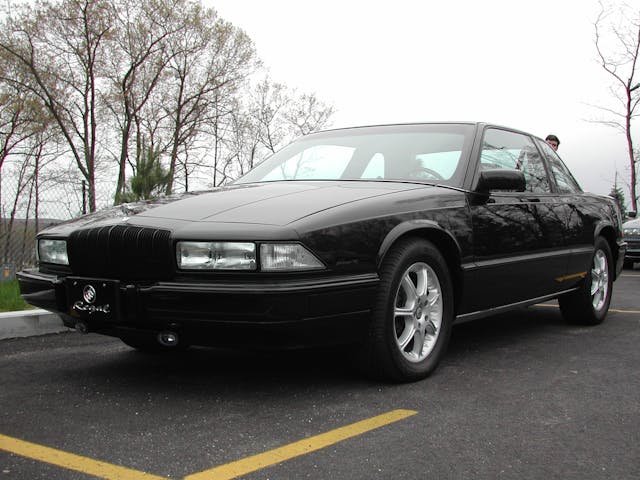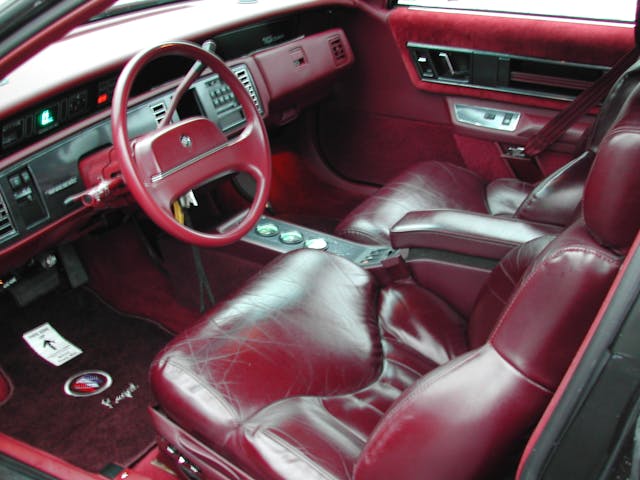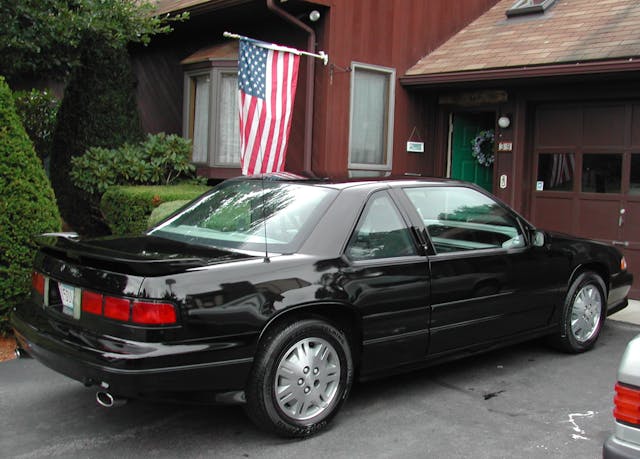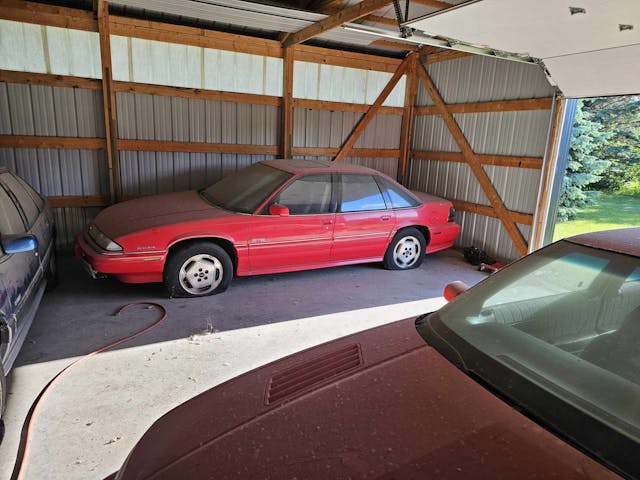Media | Articles
Piston Slap: Finding Unobtainum for Your Pontiac STE Restoration
Tom writes:
Hi Sajeev,
Long time reader. I appreciate your writings, and your passion for ’90s normie cars.
The backstory is this—in college (1999-2003) I was a GM “W-body” enthusiast. I inherited a Buick Regal GS from my great aunt with 17,000 miles, and I did the young kid mod my car thing, but I think I did it tastefully: I added a console and quad buckets from a Cutlass convertible, and that was just the start…





My enthusiasm led me to want (and then buy) a Lumina z34 with a stick shift, which I repainted/refurbished (I put in a leather Grand prix interior, etc). I sold that Z34 and the Buick to buy a Firebird Firehawk, started racing karts and sports cars, and here I am 20+ years later with two kids, a shelf full of racing trophies, some very cool cars: ZL1 1LE, ’98 Camaro 1LE (one of 99 1LEs made), Corvette, stick shift Silverado, etc. I say this not to brag, but more to set the stage for how silly I am….
Marketplace
Buy and sell classics with confidence
The Lumina Z34 stick shift has always lurked in the back of my brain. At the time it was the “fastest, coolest car” I could have ever afforded, and I loved how exotic it sounded. I always wanted a 4 door Oldsmobile Cutlass or Pontiac Grand Prix with that drivetrain, but they are SUPER DUPER rare (like less than 400 made combined of both).
You know where this is going.

So yes, in 2 weeks im driving from MA to Minnesota to buy what I believe is a decent 1991 Grand Prix STE with the 3.4 DOHC and 5 speed manual. But I’m worried. All of the NOS/OEM parts seemed to have been scooped up in the past 2 decades by W-body enthusiasts who didn’t fall of the wagon like I did—and I want perfection or as close to perfection as I can get.
The car will get a full repaint and i’ll have the seats/headliner reupholstered, but what to do about the “unobtainium” pieces? Some engine parts, some interior trims. What strategies have you used for weirdo car enthusiast parts?
When I pick up the STE, I’m also buying a second motor/transmission combo from a parts car the guy has (strike while the iron is hot). I guess I’m looking for an answer that I know doesn’t really exist, but of all people, you are the guy who knows this life best. I appreciate your thoughts/strategies/ wisdom.
Sajeev answers:
I am flattered and honored you’d reach out to me with this question. You are embarking on a journey that few will emulate, but many will appreciate.
Pontiac’s Special Touring Editions were always something impressive, and the “W” Body versions deserve the same treatment we enthusiasts typically give to high performance European brands that serve the same market. Not that I’d know anything about restoring a Euro-wannabe American car with a famous name. No sir, I’d never that so crazy…


Let me be clear on one thing: My experience isn’t directly applicable to you. Finding vintage NOS Ford parts seems easier than the same bits from General Motors. I am hoping we can still apply some knowledge transfer, so here’s a list of what I do to restore this 1989 Continental and keep it running:
- Rock Auto lists factory part numbers in the descriptions of their parts, so copy/paste them into Google and eBay to find vintage parts sellers across the web.
- If you can break down GM part numbers like the Ford’s four digit prefix, you can use those prefixes as eBay saved searches. (Those prefixes have saved me a lot of time and money!)
- Add terms like “Pontiac STE NOS”, “Pontiac Grand Prix OEM”, “Twin Dual Cam”, and “LQ1” into saved searches on an eBay account. Be creative, as eBay lets you store a lot of permutations as saved searches.
- Get friendly with NOS parts vendors that specialize in GM parts. If you become a customer they might be able to help in ways that us “end users” could never imagine.
- Pop part numbers into Rear Counter or a similar searchable database.
Hopefully that will help source powertrain parts for your STE. Unfortunately, new-old stock interior bits can be more challenging. So consider repairing interior parts instead of replacement. It can be a smarter move, even for me and the abundant supply of 1988-94 Continental interiors at my disposal. So let’s list these options:
- Buy a plastic welder for cheap and learn how to weld plastic parts together.
- Do a Google near me search for interior re-dying companies. I was lucky and found someone within 10 minutes of my home, and they do a fantastic job. (Ask local car dealers for referrals, too.)
- Cracked dashboard or door cards? This place has a great rep, and I’ve seen/appreciated their work first hand.
While this is just a high level overview of interior and powertrain parts collecting tips, I am confident this will help you when that lovely STE comes home and is ready for your tender loving care.
I must admit, I am a bit jealous: I forgot these were available with manual transmissions. Maybe I should burn a pile of money and do a Taurus SHO Yamaha V6 + Manual transmission swap in my 1989 Continental so I can be cool like you!
Have a question you’d like answered on Piston Slap? Send your queries to pistonslap@hagerty.com—give us as much detail as possible so we can help! Keep in mind this is a weekly column, so if you need an expedited answer, please tell me in your email.
***
Check out the Hagerty Media homepage so you don’t miss a single story, or better yet, bookmark it. To get our best stories delivered right to your inbox, subscribe to our newsletters.












Tom, I think Sajeev has given you some great leads here, but I want to pounce on one of them that has really worked well for me: plastic welding. A couple of years ago, he wrote a piece on this process, and it inspired me to try a few projects (things that I might’ve just tried to glue or epoxy, and that likely would have failed). My first real “biggie” was working on a cracked plastic radiator tank – which really didn’t work out well, but it taught me a lot, and subsequent jobs have gotten better and better results as I’ve become more proficient. If you’re not already into plastic welding, I encourage you to give it a shot on some of your Pontiac pieces!
I forgot about that story! https://www.hagerty.com/media/maintenance-and-tech/how-to-repair-broken-plastic-trim-in-the-comfort-of-home/
But I am glad it’s inspired you, as I’ve used it 2-3 times after writing that article. I am getting better with it since then, too!
It’s like hyperv6 says (somewhere down below in amongst the 800,000 words of his comments 😜) – practice, practice, practice. Some of my attempts were dismal fails. Some look like crap, but they held. Others looked presentable. You can really trace my progression by looking at the “fossil record”, so to speak. But the process is a valid option for a lot of things that I would have likely just tossed in the past.
[and who am I to poke fun at wordy comments? some of mine read like chapters in a book written by Rob Siegel]
Plastic welding! This looks like fun.
You are restoring a car more difficult than most any. The 80’s and 90’s really have no aftermarket support. The restoration places are not likely to touch these cars soon if ever.
As a Pontiac collector of its Pontiac items here is what you need to do if you are not already.
Join a GP or W body club.
Scan EBay several times a day.
Get with a dealer that is willing to do searches. I have found very rare and odd parts on the shelf yet due to a GM parts guy willing to look.
Get the parts book for the car. Some dealers have them and may sell or even give you it.
Mechanical parts are generally not an issue as they were shared.
Go to Pontiac shows and swap meets. There are many including one in July at Norwalk Ohio at the Tri power Nationals.
Note there may not be parts there but some of these people may have them at home. Also guys showing msy have parts to offer. More W body’s dhow up each year.
POCI club is a big help. Network out.
Drive around and check garages. Sometimes they parked grandpas car and it is just sitting there and nay be an easy sell.
3D printing for parts and making molds.
I just got t top caps made of s more pliable plastic molded in 3 d printed molds.
Really watch the web EBay snd Craig’s list. I have even found parts for a 1990 Fiero. Yes they stopped making the car in 1988 but I found prototype parts on both sites.
You can reach perfection but it will take time and effort. This is only for the brave.
If you see extra parts still buy them. I got an extra set of TTops for the Fiero as one drop where am I going to get them. One drop and you are roof less. The NOS set is back up snd also could be sold if needed later.
Network as much as you can with each contact as one can lead to another. That is how I found a Fiero Billboard that I only know of two existing.
Don’t give up no matter what.
On plastic weld some things repair well some not just depends on the plastic and surface area.
Practice before doing any repairs and test it on the type of material you are working on.
One last note. You may have to fabricate or adapt parts. This is something that needs to be done as some parts will never be reproduced.
Good Example is the 1990 GTP Fiero in the GM collection. It has large black C pillars. They originally were tinted black and you could see through them so there was no blind spot.
Well They cracked over time and Pontiac had no back up as there was only one car produced. To save them they painted it black after the repair to cover the cracks and material used. While not accurate it kept the look of the car and to be honest in this case few knew any different.
Buy the GM parts and illustrated book that is closest to your year*, and learn all the sections. Search the GM part numbers online and with GM dealers’ ‘locator’. Most dealership parts guys are too busy to luck stuff up for you, but if you call and ask ‘can you run a number on locator?’ they likely will. When you find a counter guy who’s more than a little helpful, go meet him, shake his hand and buy him lunch. Rinse and repeat.
* GM updated and reprinted the catalogs every few years, and obsoleted numbers are just ‘gone.’
You should own a Rambler… or any other AMC other than a Javelin or AMX. Repro parts are few, and mostly mechanical parts or other wear parts such as rubber mounts exclusive to Rambler/AMC cars. Trim parts are notoriously hard to find, and even some mechanical parts (like a 63-66 CV joint repair kit) are made of unobtanium. There are only a few specialty vendors, and any of us long time Rambler/AMC people can name them by heart. Seeking out parts has always been a challenge, and of course not getting any better. To do a complete restoration on even one of the more mundane cars is nearly impossible, and if you CAN source NOS parts it quickly costs way more than the car will be worth on the open market — and even amongst AMC/Rambler enthusiasts! Repair where you can, substitute/modify something from another make when possible — those are often the only choices. Welcome to our world!
The W Body STE’s are awesome. I had a 1990 GP Turbo car and it was a blast. That was a turbo charged 3.1 by McClaren. I had a friends dad bought a 1990 STE brand new in 1990. I loved that car. My wife loved her old A Body 6000 STE, 1986, back in the day.